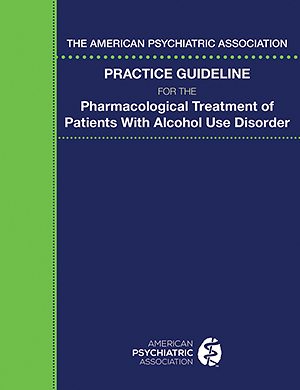This practice guideline incorporates available evidence on the treatment of AUD; however, additional research is essential (Jonas et al. 2014; Litten et al. 2014). More knowledge is needed about the basic neurobiology and genetics of AUD if we are to understand the etiology of this disorder and develop novel treatments. In terms of clinical practice, most knowledge of assessment and documentation is based on clinical consensus. Well-designed studies can be difficult to conduct when they include topics such as the following:
▫
Developing and documenting a comprehensive, person-centered, evidence-based plan of treatment
▫
Discussing, gaining patient agreement to, and documenting initial goals of treatment, including legal obligations and risks to self or others
▫
Assessing current and past tobacco, alcohol, and other substance use
▫
Assessing for co-occurring conditions that are common in individuals with AUD or that would influence treatment choices
In terms of other means of assessing individuals with AUD, additional research is needed on topics such as the following:
▫
Optimizing selection and use of quantitative measures for initial evaluation and for longitudinal monitoring
▫
Individualizing selection of a physiological biomarker for initial evaluation and for longitudinal monitoring, based on the goals of treatment, goals of monitoring, and test performance (including predictive value)
▫
Determining the appropriate frequency of longitudinal monitoring with quantitative measures and with physiological biomarkers
Although naltrexone and acamprosate have been well studied in placebo-controlled and some head-to-head trials, other pharmacotherapies for AUD require additional study with adequately powered sample sizes and appropriate methods for analysis of missing data. We also need more knowledge on the efficacy, effectiveness, and adverse events of available and novel pharmacotherapies for AUD in individuals with
▫
Other co-occurring psychiatric conditions (including other substance use disorders)
▫
Co-occurring medical conditions, including obesity, significant cardiac disease, chronic kidney disease, and significant hepatic disease (including cirrhosis) and in individuals who have had a liver transplant
▫
Differing severities of AUD, including mild AUD
▫
Different settings for treatment, including primary care, general ambulatory psychiatry, and specialized alcohol treatment programs
Measured outcomes should focus on quality of life, including physical and mental health, as well as outcomes related to alcohol consumption. In addition, studies need to identify the magnitude of reduction in alcohol consumption that is associated with a clinically meaningful effect on outcomes.
In terms of specific subgroups of patients, additional information is needed on the following:
▫
Comparative effectiveness of naltrexone versus combination therapy (e.g., acamprosate plus opioid agonist) for individuals with AUD and opioid use disorder
▫
Effects of alcohol pharmacotherapy in women who have become pregnant while taking one of these medications, as measured through registry studies
▫
Differential treatment responses that would allow personalized medication selection and dose based on factors such as the following:
▫
Patient preferences for treatment goals or approaches
▫
Pattern and amount of alcohol consumption
▫
Pharmacogenetic alleles and other biomarkers identified through genomics, epigenomics, transcriptomics, proteomics, and metabolomics
▫
Biomarkers identified through brain imaging
▫
Prior response (or lack of response) to treatment
▫
Presence or absence of specific co-occurring disorders or symptoms (e.g., suicidal ideas, aggressive behaviors, anxiety)
Other aspects of clinical pharmacotherapy for AUD that require head-to-head comparison studies and additional research include the following:
▫
Optimal period of abstinence (if any) before initiating treatment with a specific pharmacotherapy
▫
Use of AUD pharmacotherapy, such as disulfiram or naltrexone, on a short-term basis to reduce initial risk of relapse after hospitalization or detoxification
▫
Initiation of treatment while the patient is still consuming alcohol
▫
Optimal type, frequency, and duration of nonpharmacological treatments used in combination with pharmacotherapies for AUD
▫
Duration of treatment needed once the patient has achieved abstinence or a reduction in alcohol consumption
▫
Duration of treatment needed before changing to a different medication in a patient with a lack of response or a partial response to treatment
▫
Sequence with which treatment options (including pharmacological and nonpharmacological approaches) should be used
▫
Impact of different medication formulations (e.g. oral, long-acting injectable, implantable) on treatment outcomes, including adverse events
Finally, we need more studies on ways to improve the quality of care that is received by individuals with AUD, including the following:
▫
Developing educational initiatives or health care delivery system changes to enhance guideline adherence
▫
Identifying approaches to address underuse of guideline-concordant pharmacotherapy of AUD
▫
Addressing disparities in access to and receipt of guideline-concordant treatment for AUD
▫
Developing improved approaches to reduce treatment dropouts and maintain adherence to pharmacotherapy
▫
Developing and testing of additional quality measures aimed at assuring improved patient outcomes and receipt of evidence-based care, including pharmacotherapy
Together with the already sizable evidence base on AUD and its treatment, additional research on these and other topics could lead to significant improvements in outcomes for patients with AUD.
